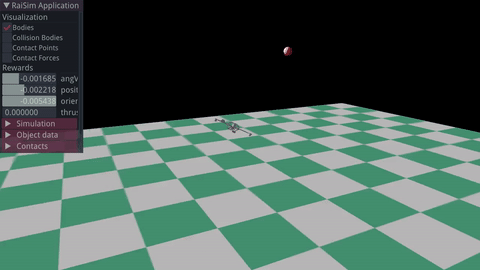raisimGym: RL examples using raisim
What is raisimGym
raisimGym is an example of a gym environment using raisim. It uses stable-baselines (https://github.com/hill-a/stable-baselines) for training and pybind11 (https://github.com/pybind/pybind11) for wrapping raisim in python.
News
- There was a bug in the examples. The P gain was set to a wrong dimension. This is fixed as of v0.3.2. Please update to the latest version. If you used the example as a template for your project, please fix your project as well.
Requirements
- Linux only. support ubuntu 16.04 and 18.04 but might work on other distributions
- g++, gcc > 6 (how to install?)
- cmake > 3.10 (how to install?)
Install
Please install/save everything locally to prevent corrupting your system files. We will assume that you have a single workspace where you save all repos related to raisim.
Here we introduce two variables
- WORKSPACE: workspace where you clone your git repos
- LOCAL_BUILD: build directory where you install exported cmake libraries
You can check out our docker file if you are stuck.
Python setup
- Install python3
- For Ubuntu18.04 (sudo apt-get install -y cmake python3.6-dev python3-pip libpython3.6-dev)
- For Ubuntu16.04 (sudo apt-get install -y cmake python3.5-dev python3-pip libpython3.5-dev)
- Setup your python environment (virtualenv or conda) with Python > 3.5
Dependencies
Install the following dependencies
- Raisim (https://github.com/leggedrobotics/raisimLib)
- RaisimOgre (https://github.com/leggedrobotics/raisimOgre)
- yaml-cpp (sudo apt-get install libyaml-cpp-dev)
- tensorflow (pip3 install tensorflow==1.14 or pip3 install tensorflow-gpu==1.14))
- tensorboard (pip3 install tensorboard==1.14)
Now install pybind11 as following
dependencies
sudo apt-get install libpython[VERSION OF YOUR CHOICE]-dev
pybind11
cd $WORKSPACE
git clone https://github.com/pybind/pybind11.git
cd pybind11 && git checkout v2.4.3 && mkdir build && cd build
cmake .. -DCMAKE_INSTALL_PREFIX=$LOCAL_BUILD -DPYBIND11_TEST=OFF
make install -j4
You might have to add LOCAL_BUILD/lib to your $LD_LIBRARY_PATH to ensure that ld finds Ogre3D shared objects.
Workflow
- Compile your c++ environment (instructions followed)
- Run your learning script (instructions followed)
or use the dockerfile provided (instruction below)
Compile
Set your compiler to g++>6.0 as following
export CXX=/usr/bin/g++-8 && export CC=/usr/bin/gcc-8
Now compile raisimGym as
python3 setup.py install --CMAKE_PREFIX_PATH $LOCAL_BUILD --env /WHERE/YOUR/CUSTOM/ENVIRONMENT/IS
The "--env" directory should include a file called "Environment.hpp" which contains ENVIRONMENT class.
Compiling examples
We provide a shortcut for building examples. Replace $EXAMPLE_NAME by one of the following names: anymal, laikago, and quadrotor
python3 setup.py install --CMAKE_PREFIX_PATH $LOCAL_BUILD --env $EXAMPLE_NAME
Run
You can make your own runner. To use the example runner,
python3 scripts/anymal_blind_locomotion.py
You can also test your trained model. To use the example runner,
python3 scripts/anymal_blind_locomotion.py --mode test --weight /WHERE/YOUR/CUSTOM/MODEL/IS
You can continue to improve your model based on pre-trained model. To use the example runner,
python3 scripts/anymal_blind_locomotion.py --mode retrain --weight /WHERE/YOUR/CUSTOM/MODEL/IS
How to debug
C++ is much more efficient than python but it is more prone to errors and you will often see segfaults. The standard tools to fix bugs in C++ are GDB and Valgrind. But it is hard to use them with Python (it is possible but just not as convenient). The recommended debugging option for raisimGym is to use the built-in debugging app which can be compiled by passing --Debug flag while running setup.py
For e.g., python3 setup.py install --CMAKE_PREFIX_PATH $LOCAL_BUILD --env anymal --Debug
This creates an executable. This executable takes three arguments: 1. resource directory 2. configuration file 3. "render" or "no_render". If you choose to render, valgrind will detect many errors in the graphics driver and renderder. These are memory leaks that will not crash your execution.
Using raisimGym in Docker
- Install docker and Nvidia-docker2 (instruction).
- Build an image
docker build -t raisim_gym $WORKSPACE/raisimGym/dockers/gpu - Create a container using the provided docker runner
$WORKSPACE/raisimGym/dockers/gpu/runner.bash - Inside the container, compile your environment and execute your runner
Tutorial
Dr. Inkyu Sa kindly provided a comphensive tutorial on raisimGym here
Examples of trained policies
ANYmal
- Trained with RTX 2080 + Intel 8700K + PPO [1]
- 18 dof quadrupedal robot, 34-dimentional observation space
| Initial policy | 38 seconds of training |
|---|---|
 |
 |
| 76 seconds of training | 112 seconds of training |
|---|---|
 |
 |
Quadrotor
This quadrotor example is not fully tuned for real applications. Please feel free to optimize the example

Notes
- Due to conversion between numpy and eigen, the interface class (e.g., VectorizedEnv) should use row major matrices only.
Common issues and workarounds
- When build fails, try again after deleting the
buildfolder
How to contribute?
raisimGym is meant to be a minimal example. Please do not submit a pull request that contains features targeting specific applications. Bug fix/code clean-up are welcome.
Fork the repo, make changes and then send a pull request. Instructions can be found here
References
[1] Schulman, John, et al. "Proximal policy optimization algorithms." arXiv preprint arXiv:1707.06347 (2017).
Contributors
Jemin Hwangbo is developing/manaing raisimGym with help from the followig contributors
- Inkyu Sa
- Haloted